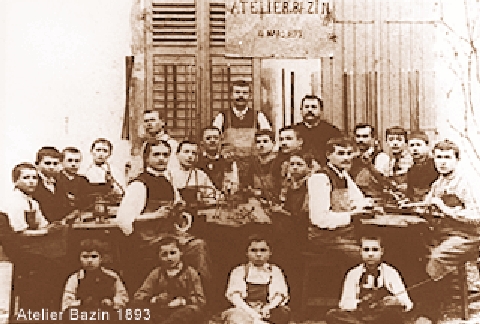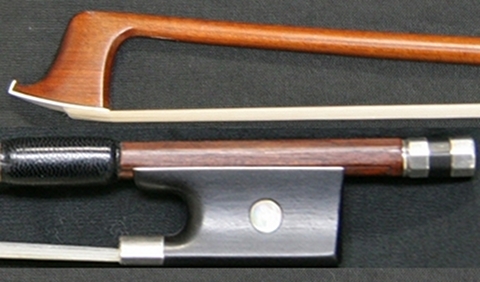THE BAZINS; FRANCOIS XAVIER THE FOUNDER
After having left behind the ancient period, consisting of individual craftsmen and workshops of excellence, this week we begin to talk about a new phase, just as important for the French bowmaking, that one of the families. We start from the most long-lived one : the Bazins.

As often said, from a certain point onwards, the French bowmaking undergoes a remarkable change. '8oo is the century of the Industrial Revolution and the social arrangements are under constant change.
The Working Class is born and the workers begin to have rights, as well as duties, which lead to an increase in general living standards. The demand for instruments and bows grow, favoring , even in our world, a small revolution
The workshops are transformed from small groups of two or three craftsmen, usually teacher and students, into real factories. In the past we could meet mainly bows made in cooperation: Dominique Peccatte / Pierre Simon or Etienne Pajeot / Joseph Fonclause, just to name a few. In these workshops one worked as in an assembly line.
The advantage brought by this working way is, of course, greater production capacity, but as always, there is also a downside.
Even if the bows were of good, or often of excellent quality, they were impersonal, both aesthetically than in sound. Since they were pool leveled bows, aesthetics was not considered to be so important, but the mechanic was, for sure.
Well, if I am a master bow maker who produces a small quantity of bows, I can afford to choose the best students and teach them everything I know, because I wish that those working for me, could do it in the right way, no matter how long it takes.
But if I have a small factory, I need to optimize expenses to keep it running and the best way to do this is to speed up the processing stages. As you may recall, Voirin, already during Vuillaume's age, was studying faster construction techniques, the most important one was certainly to change the curve model.
This way of building has led to a gradual but inexorable depletion of the great French bowmaking school. If the teachers who know everything, don't spread it , today's students, masters of tomorrow, will produce students who do not know everything.
The modern French bowmaking should thank, and it does, people like Bernard Ouchard, excellent bowmaker , but especially important for his research and the rediscovery of the ancient tradition. Unfortunately for him in the first place and the French bow making, in the second, he died at the age of 54 years only.
One of the most important and long-lived families is with no doubt the Bazins, the first of one we will deal of.
Francois Xavier Bazin

The founder of this family of craftsmen (including at least eight of the most important violin and bowmakers ) is Francois Xavier Bazin.
Born in Mirecourt on May 10, 1824 by Joseph Eustache Bazin, judiciary clerk, and Marguerite Laurent, the young man approaches the construction of instruments and bows with his cousin Joseph Eustache II, thanks to a kind of second job of both his father and uncle. The former had worked for the violin maker Francois Didelot and the latter had a close friendship with the brother of Pierre Simon, Bartélémy.
Through this contact, the oral tradition reports that Francois Xavier in the late thirties of the nineteenth century, went to Paris to study with Dominique Peccatte, who despite his young age, was already known. Unfortunately no documents were found to confirm it.
On August 25, 1845 he married an embroiderer , Jeanne Hélène Maucotel and settles in Mirecourt with its business. The couple has six children, including Charles Nicolas (II), Charles Nicolas (I), also a bow maker, was the brother of Francois Xavier that will take up the laboratory at the time of his father's death.
The family enjoys a relatively well social position and also own some vines in Les Hauts de Caumont.
During the '60s, Charles Nicolas (II) begins his apprenticeship with his father, but unfortunately he left him very soon. He died of cholera on August 1, 1865.
The son, just 18 years old, will take up his father's company and for the first period he will continue to use his father's brand.
The style
Unfortunately I do not have a proper picture to show you, also because of his untimely death, Francois Xavier's bows are not so easy to find.
Two are the periods of his work. The first, characterized by lines that remind authors such as Maline and Fonclause, with angular shapes influenced the Peccattian school. In the late '50s, following the current fashion, he comes back to a softer style similar to Voirin's one.
Next week we will talk about Charles Nicols Bazin (II)
So long
Paolo
|